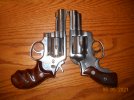Petrol & Powder
Well-Known Member
Wow, where to start? The Ruger DA Six series revolvers (Security-Six, Service-Six & Speed-Six) hold a special place in the world of DA revolvers. They were game changers in terms of manufacturing methods, design, and value. I think every Ruger fan felt a twinge of sadness when they were discontinued.
The often-quoted phrase of, “The size of a K-frame with the strength of a L-frame” just about sums up the type. It is that strength that endears the DA -Six’s to their owners. The cast steel frame made without removable side plates is part of that strength. The overall use of beefier components in the lockwork adds strength. The materials used are excellent. Everything about the design is geared towards durability. William Ruger had capitalized on the advantages of cast steel in prior projects, and he applied that manufacturing process to the DA revolver type in the early 1970’s. The result was a line of DA revolvers that combined high strength materials, a high strength design and a low manufacturing cost. It was a winning formula and between 1972 and 1988, over 1.4 million DA-Six series revolvers were produced.
Ruger’s primary competitors in the DA revolver field were S&W and Colt.
Ruger was attempting to take market share away from the old guard. The biggest challenge for S&W and Colt was their manufacturing processes were more costly. Ruger could inexpensively cast a part that was very close to its final form and finish it with a minimal amount of machining. Of course, S&W and Colt fought back. Advertising was filled with accusations and insinuations. S&W would claim that cast parts were weaker (50 years later, clearly that is not true). S&W claimed that Ruger had to use thicker parts because of the cast steel. (Which is a twisted way of saying Ruger Chose to use thicker steel because they could for the same cost). All is fair in love and war, and marketing is war.
Ruger never pushed S&W off the top of the hill, but they did gain market share. Ruger won some law enforcement contracts, they gained ground in civilian sales, they got some overseas contracts. Ruger earned loyal customers.
There were more variations of the Ruger DA Six series than I could possibly identify but the series was divided into three major groups: Security-Six, Service-Six and Speed-Six.
The Security-Six was a square butt frame with adjustable sights. The Service-Six (Sometimes labeled the Police Service-Six) was a square butt frame with fixed sights. And the Speed-Six was a round butt frame with fixed sights. All models were available in carbon steel or stainless steel. They were chambered in 38 Special, 357 magnum, 9mm Luger and 38/200. Most of the guns sold in the U.S.A. were chambered in either 38 Special or 357 Magnum.
Smith & Wesson introduced the L-frames in 1980 and Ruger introduced the GP-100 in 1985. The last of the DA Six series guns were made in 1988 and that was the end of an era.
The often-quoted phrase of, “The size of a K-frame with the strength of a L-frame” just about sums up the type. It is that strength that endears the DA -Six’s to their owners. The cast steel frame made without removable side plates is part of that strength. The overall use of beefier components in the lockwork adds strength. The materials used are excellent. Everything about the design is geared towards durability. William Ruger had capitalized on the advantages of cast steel in prior projects, and he applied that manufacturing process to the DA revolver type in the early 1970’s. The result was a line of DA revolvers that combined high strength materials, a high strength design and a low manufacturing cost. It was a winning formula and between 1972 and 1988, over 1.4 million DA-Six series revolvers were produced.
Ruger’s primary competitors in the DA revolver field were S&W and Colt.
Ruger was attempting to take market share away from the old guard. The biggest challenge for S&W and Colt was their manufacturing processes were more costly. Ruger could inexpensively cast a part that was very close to its final form and finish it with a minimal amount of machining. Of course, S&W and Colt fought back. Advertising was filled with accusations and insinuations. S&W would claim that cast parts were weaker (50 years later, clearly that is not true). S&W claimed that Ruger had to use thicker parts because of the cast steel. (Which is a twisted way of saying Ruger Chose to use thicker steel because they could for the same cost). All is fair in love and war, and marketing is war.
Ruger never pushed S&W off the top of the hill, but they did gain market share. Ruger won some law enforcement contracts, they gained ground in civilian sales, they got some overseas contracts. Ruger earned loyal customers.
There were more variations of the Ruger DA Six series than I could possibly identify but the series was divided into three major groups: Security-Six, Service-Six and Speed-Six.
The Security-Six was a square butt frame with adjustable sights. The Service-Six (Sometimes labeled the Police Service-Six) was a square butt frame with fixed sights. And the Speed-Six was a round butt frame with fixed sights. All models were available in carbon steel or stainless steel. They were chambered in 38 Special, 357 magnum, 9mm Luger and 38/200. Most of the guns sold in the U.S.A. were chambered in either 38 Special or 357 Magnum.
Smith & Wesson introduced the L-frames in 1980 and Ruger introduced the GP-100 in 1985. The last of the DA Six series guns were made in 1988 and that was the end of an era.

